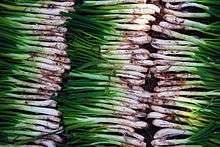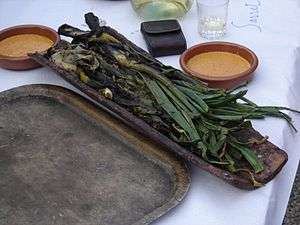Calçot
Calçot (Catalan pronunciation: [kəlˈsɔt]) is a type of green onion known as calçot in the Catalan language. The calçot from Valls (Tarragona, Catalonia, Spain) is a registered EU Protected Geographical Indication.[1]
| Calçot | |
|---|---|
 | |
| Species | Allium cepa |
| Cultivar | Calçot |
| Origin | Catalonia |
Calçots are milder and less bulbous than onions and have a length of between 15 and 25 cm (white part) and a diameter of 1.7 to 2.5 cm at the root. Planted in trenches, like an onion, as a single bulb, and successively increasing the depth of the soil around the stems throughout autumn and winter, they sprout into 4–10 shoots, roughly the shape of small leeks or scallions.
Calçotada is an annual event in Valls, Catalonia, Spain, celebrating the harvest of calçots. They are grilled over a hot fire, wrapped up in newspaper, served on terra cotta tiles and eaten, after peeling with bare hands, by dipping them one by one in salvitxada sauce and are accompanied by red wine and bread. A course of roasted lamb and sausage and white beans follows. For dessert, oranges and white cava are served.[2]
Origin
The origin of the variety is disputed, but one of the most commonly accepted versions [unsubstantiated] of its history is that they were developed by Xat de Benaiges, a peasant farmer from Valls around the turn of the 20th century. He is said to have been the first to have planted the sprouts of garden onions, covering them with earth so a longer portion of the stems remained white and edible. That action is known in Catalan as calçar, (a Catalan agricultural term which means to cover the trunk of a plant or vegetable with soil. As the plant grows, soil is continuously added, i.e., "calçar"), hence the name calçot.
Calçotada
The most traditional way of eating calçots is at a calçotada (plural: calçotades), an annual gastronomical celebration held between November and April,[3] where barbecued calçots are consumed in massive quantities.[4]
Calçots are grilled until charred, wrapped in newspaper to steam, then consumed by peeling off the charred skin and dipping the white portion in salvitxada or romesco sauce. The green tops are discarded. The calçots are accompanied by red wine or cava sparkling wine. Pieces of meat and bread slices are roasted in the charcoal after cooking the calçots.[4]
Gallery
- Calçot
 Pulling off the calçots
Pulling off the calçots- Calçots roasting during a calçotada
- Handling Calçots
 Roasted calçots with romesco sauce for dipping
Roasted calçots with romesco sauce for dipping
See also
- Traditions of Catalonia
- Ramps, another species of Allium around which festivals are held
References
- "Els "Calçots"". Archived from the original on 2010-03-10. Retrieved 2010-02-07.
- A Catalan Barbecue March/ April 2014 page 112 AFAR
- "La Gran Fiesta de la CALÇOTADA" el Alt Camp (Spanish)
- "The Calçotada: From Spain to Your Backyard" (February 25, 2013) Catavino
Further reading
- Jofre, Joan; Garcia, Agustí. La cuina del calçot (in Catalan). Cossetània edicions. ISBN 84-9791-075-3.
- Various authors (1999) El calçot i el seu entorn: Actes del I Congrés de la Cuina del Calçot (El Cullerot) (Catalan) ISBN 978-8489890282
.jpg)